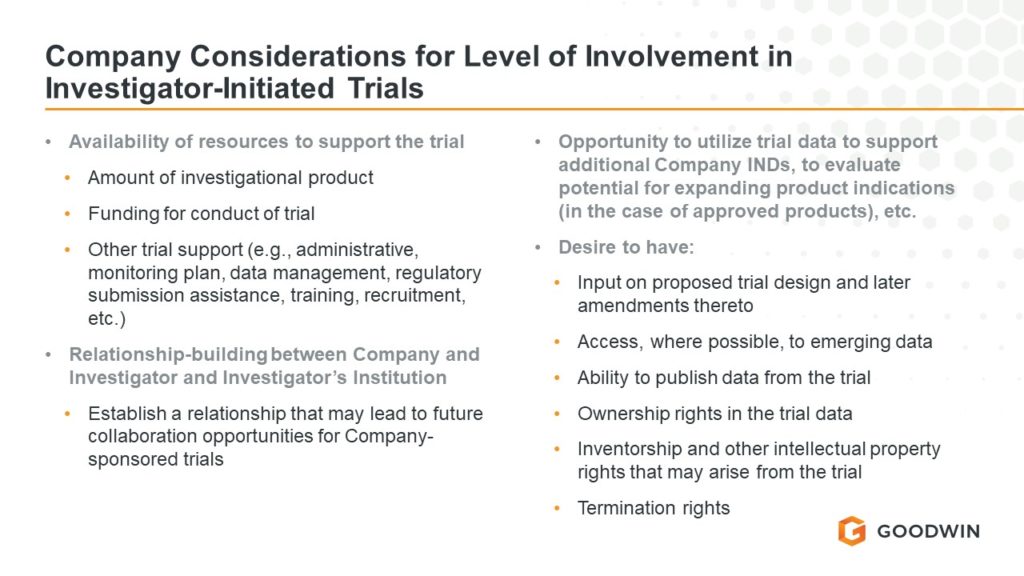Master(ing) Protocols for Randomized Umbrella and Platform Trials
 The U.S. Food and Drug Administration (FDA) recently issued a draft guidance, “Master Protocols for Drug and Biological Product Development”, that echoes and builds on principles that the Agency previously set forth in guidance for COVID-19 master protocols (2019), master protocols in oncology (2022) and clinical trials for multiple versions of cellular or gene therapy products (2022). The draft guidance offers numerous (and at times very detailed) recommendations to facilitate the design, efficient analysis of data, and regulatory review of clinical trials conducted under such master protocols.
The U.S. Food and Drug Administration (FDA) recently issued a draft guidance, “Master Protocols for Drug and Biological Product Development”, that echoes and builds on principles that the Agency previously set forth in guidance for COVID-19 master protocols (2019), master protocols in oncology (2022) and clinical trials for multiple versions of cellular or gene therapy products (2022). The draft guidance offers numerous (and at times very detailed) recommendations to facilitate the design, efficient analysis of data, and regulatory review of clinical trials conducted under such master protocols.
As a starting point, this draft guidance defines several key terms, including the types of trials that can be conducted under a master protocol:
| Master Protocol | a protocol designed with multiple substudies, which may have different objectives and involve coordinated efforts to evaluate one or more medical products in one or more diseases or conditions within the overall study structure. |
| Umbrella Trial | evaluates multiple medical products concurrently for a single disease or condition |
| Platform Trial | evaluates multiple medical products for a disease or condition in an ongoing manner, with medical products entering or leaving the platform |
| Basket Trial | evaluates a medical product for multiple diseases, conditions, or disease subtypes |
Master protocols offer sponsors the ability to streamline drug development through shared control groups, study infrastructure and oversight. However, these protocols also involve increased complexities and design challenges that generally require a higher degree of coordination. Here, we highlight some key design and analysis considerations addressed in the draft guidance:
Randomization
Sponsors should consider allocating more subjects to control arms than for each individual drug arm to increase power and reduce the risk of a poorly or highly performing control arm. For a platform trial, a sponsor should create a plan for changes to the randomization ratios that can occur as products enter and exit a platform trial. In umbrella or platform trials comparing different drugs, the sponsor should ensure that the randomization process prevents subjects from being randomized to drugs they are not eligible to receive given each drug’s exclusion criteria.
Informed Consent
Sponsors should cover all treatment arms in their informed consent and obtain consent prior to randomization. In a platform trial where drugs are entering and exiting the study, consent forms should be modified accordingly to reflect the drugs currently under evaluation. FDA also recommends the use of a central IRB to review informed consent forms, the protocol, and other relevant documents for monitoring of a trial conducted under a master protocol.
Blinding
Given the potential for different administration methods for various drugs included in umbrella or platform trials, unique blinding challenges may arise and sponsors should discuss their proposed approach to blinding with FDA early in the planning stage.
Safety Data
Safety data from a master protocol can be considered part of overall safety database but data from other sources may be needed to support approval. The type of master protocol and the drugs being evaluated will impact the approach to safety data collection. FDA also recommends that a data monitoring committee (DMC) or other independent, external entity review accumulating safety and efficacy data to minimize inadvertent dissemination of information that could pose risks to trial integrity.
Regulatory Review Considerations
Each master protocol should be submitted as a new IND, and FDA recommends that the sponsor request a pre-IND meeting to discuss the protocol and other IND submission details. Given the potentially rapid pace of changes in a master protocol, the draft guidance recommends specific procedures for protocol amendments, including cover letters for each protocol amendment that update on the status of each drug and notifying the RPM at least 48 hours before submitting any protocol amendment that could substantively affect the master protocol. The IND should also include a well-designed communication plan to facilitate timely and effective communication between multiple stakeholders, including rapid communication of serious safety information and protocol amendments to investigators and FDA.
* * * *
Comments on this draft guidance are due February 22, 2024. Please contact the authors or your Goodwin attorney with any questions or if you would like to submit a comment.
 The Bioresearch Monitoring (BIMO) Program, operated by the U.S. Food and Drug Administration (FDA), conducts on-site inspections and data audits in order to effectively monitor the compliance of all FDA-regulated research.
The Bioresearch Monitoring (BIMO) Program, operated by the U.S. Food and Drug Administration (FDA), conducts on-site inspections and data audits in order to effectively monitor the compliance of all FDA-regulated research.

 Clinical trial diversity is not a new concept–the U.S. Food and Drug Administration (FDA) issued a
Clinical trial diversity is not a new concept–the U.S. Food and Drug Administration (FDA) issued a 
